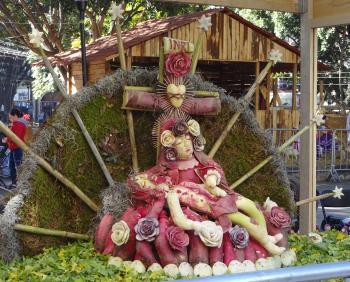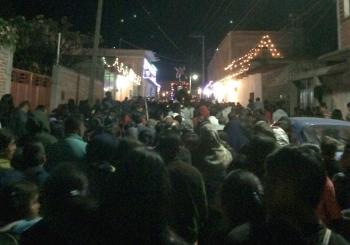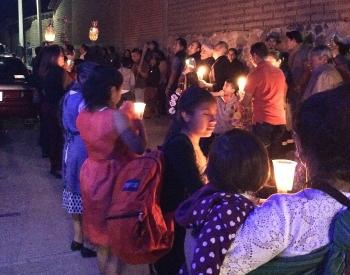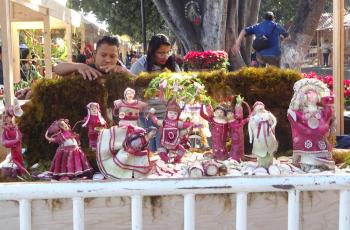Wonderful winter celebrations in Mexico
This article appears on page 41 of the January 2019 issue.
Oaxaca is a great place to spend the winter holidays. During a 2-week, self-planned trip in December 2017, I found delightful weather, clean air and friendly people who loved to party.
And December is party month in Mexico. It starts with the Feast of Guadalupe on the 12th, followed by festivities for a local favorite, Our Lady of Solitude, and winds up with Christmas and New Year's celebrations. During this time, there are fairs, festivals, craft shows, parades, processions and fireworks.
Getting there
My original travel companion for this trip had to cancel at the last minute, but I was lucky to be meeting up with two friends from Ireland. The day after I arrived in Oaxaca, the three of us hired a driver to take us to Teotitlán del Valle, where I had arranged to participate in a posada with Oaxaca Cultural Navigator (www.oaxacaculture.com).
Las Posadas processions replicate the experience of the Holy Family being repeatedly turned away from lodging upon their arrival in Bethlehem. During the 9-day event prior to Christmas, statues of Mary and Joseph are carried from house to house before they are returned to the church for Christmas Eve.
For all of us, it was our first trip to Oaxaca, so we made use of the 45-minute journey to Teotitlán to explore the area. (There are other towns called Teotitlán in the state of Oaxaca, but I will refer to Teotitlán del Valle as only Teotitlán in this article.)
On the way to Teotitlán, we stopped in the town of Santa María del Tule to see its massive, 2,000-year-old cypress tree.
To get past the gate surrounding the tree costs 10 pesos (50¢). While you can easily see the tree from outside the fencing, the money supports the tree's care and the church on whose grounds the tree is located.
There was also a well-designed mezcal-production demonstration and tasting site (Don Agave) on the main road, at the turnoff to Teotitlán. The product is artisanal, so it's quite expensive, but the information provided and the personality of our guide made it a worthwhile visit.
Teotitlán
Teotitlán is a weavers' village, so we arrived early and visited four different fabricas (weaving workshops) to see their carpets and learn about the carpet-making and yarn-dying processes.
Teotitlán and other Zapotec villages have long been known for their weaving arts. In the not-so-distant past, the craft focused on blankets and serapes until, the story goes, an enterprising visitor suggested they branch out into rug making. About 150 local families are now involved in the craft.
Our first stop was Casa Cruz (Avenida B. Juárez 190), one of the more well-known and publicized fabricas. The owner's son gave a very good demonstration of the use of natural dyes before showing us carpets for sale.
The natural-dye demonstration has become a fixture at the Teotitlán fabricas, but it was pointed out to us later that, while many workshops advertise a "demonstration" of natural-dye techniques, not all workshops employ the natural dyes in their work.
One of the most fascinating natural dye products is made from dried cochineal, a parasitic scale insect found on cactus, which produces a wide range of shades, mostly in the red spectrum, depending on the reactive agent used with it.
After our carpet exploration, we met with Oaxaca Cultural Navigator's Norma Schafer, an American who is a part-time resident of Teoti tlán, at Tierra Antigua restaurant (Avenida Benito Juárez 175). Norma introduced her group of seven travelers to the restaurant's owners, Pedro and Carina Montaño, from whom she rents her cottage.
Pedro described community life in this Zapotec village. Everyone living there is a member of the comunidad. At the age of 18 (sometimes younger), villagers are expected to participate in community life, whether it's sweeping up after the weekly market or sitting on one of the committees that help to run the village, including those that see that the church is maintained or that make rules about land and water use. This tequio, or performance of duties without monetary compensation, is a local custom.
They also make decisions about who can buy property in the village. While outsiders can rent, it is rare for an outsider to own a business or home; those who do usually have married into the village.
The weaving brings in good money and numerous travelers, and much of the land is owned and worked communally.
Pedro also described guelaguetza, an informal exchange of goods and services among family, friends and neighbors, with customary expectations for the exchange. The example Pedro used is that your neighbor might gift you a side of beef to prepare a feast for your daughter's wedding. In exchange, you would be expected to make a similar gift in the future to your neighbor for a feast they were preparing.
A memorable night
The concept of guelaguetza also applies to the preparations for Las Posadas, as it is an expensive undertaking for the individual families who each sponsor an evening. (Norma said it can cost a family more than $25,000.)
Your relatives descend on your home for three days: the day before the statues arrive, the day the statues are with you and the day they depart. The sponsoring family is responsible for feeding everyone and giving their guests gifts. The family we were with for a few hours gave all the women shawls, and all the men got shopping bags.
We each got a plate with an orange, nectarine, tangerine and banana. At first, I thought it was to carry in the procession, but Norma said it was a guest gift.
Folding tables had been set up in their courtyard, and about 70 relatives and family friends were fed. When dinner was finished, the courtyard was cleared and a band of about 30 musicians set up at one end while over 40 piñatas were smashed by different members of the family, scattering goodies that were scooped up by young and old alike. The bags the men got as gifts suddenly made sense.
After they had "killed" enough piñatas, the family that was going to receive the statues later that evening arrived. Members of both families went into a little chapel off the courtyard where the statues were and prayed together. At dusk, the procession began.
Led by a solemn band and two lines of people holding candles (one line for the family from which the statues were departing and one line for the family to which the statues were going), a palanquin with the statues was lifted onto the shoulders of four young women. This was followed by another band, this one loud and raucous, and the two bands took turns playing solemn and slow and rowdy and energetic music.
Norma's small group and a few dozen other neighbors followed as the procession wound its way 2 miles to the next house, each new block announced by a riot of firecrackers and rockets.
By the time we arrived at the next posada house, where the statues would next be hosted, there were several hundred people in the procession (in a village of just 5,000 people). There is nothing quite like the sensation of about 10% of a town's population turning out to take a slow stroll on a winter's night.
At the next house, most of the crowd petered away, but we were invited in, and some of the group joined the family and the statues in their chapel to pray the rosary. By the time they finished, it was 9 p.m. We left before they served dinner to the 50 or so people who remained in their courtyard.
While in Oaxaca, I experienced other Los Posadas processions in the city, itself, but they felt more staged and less religious than the one in Teotitlán del Valle.
An unusual competition
The other special Oaxacan event at that time of year is the Noche de los Rábanos (Night of the Radishes). Specially grown, oversized radishes are carved to create elaborate scenes, and a competition, started in 1897, is held in the main square every December 23rd to judge the final works.
The carvers begin setting up in the early afternoon, which is the best time to see what's going on. Even though the scenes are still being set up, it's not as crowded as it gets in the late afternoon and evening, when the viewing officially opens and the line to pass by the exhibits winds around the cathedral. By morning, it's all gone.
Even though you may arrive early to look at the exhibits, it's worth going back in the evening to listen to the orchestra that sets up in the center of the park, to people-watch and to check out the dozens of vendors selling food and toys.
Some of my favorite radish scenes included monsters and dragons, models of local churches and crèches.
This is just a small part of what's available to see and do in and around Oaxaca. Travel in the area is inexpensive. Buses are very inexpensive, and you can hire a taxi for about $10 per hour (2017 prices), while $100 a day seems to be an average rate for longer trips that require the driver to stay overnight. We paid $125 per person for our Las Posadas night with Norma, who also specializes in weaving-focused tours and walks.




